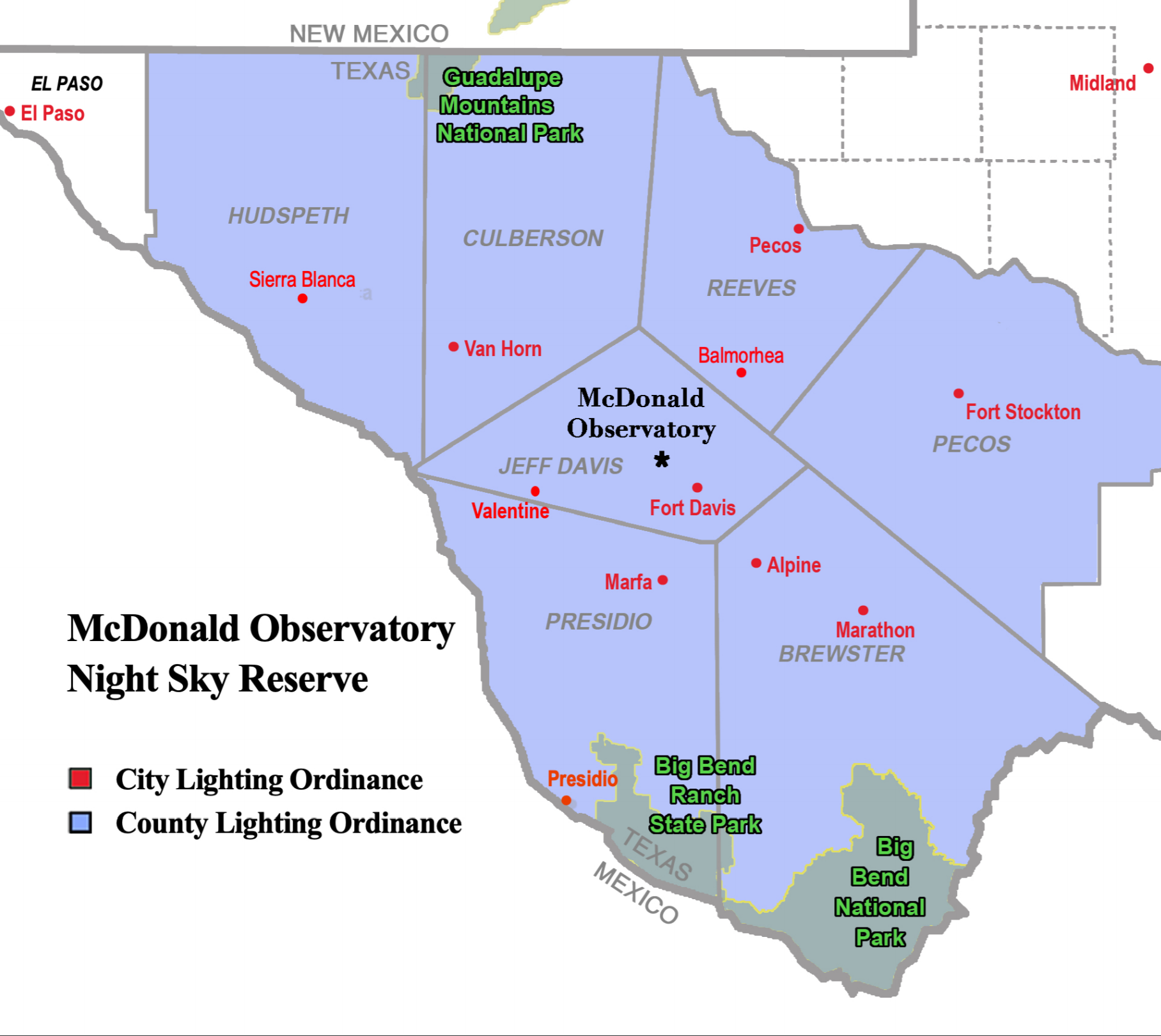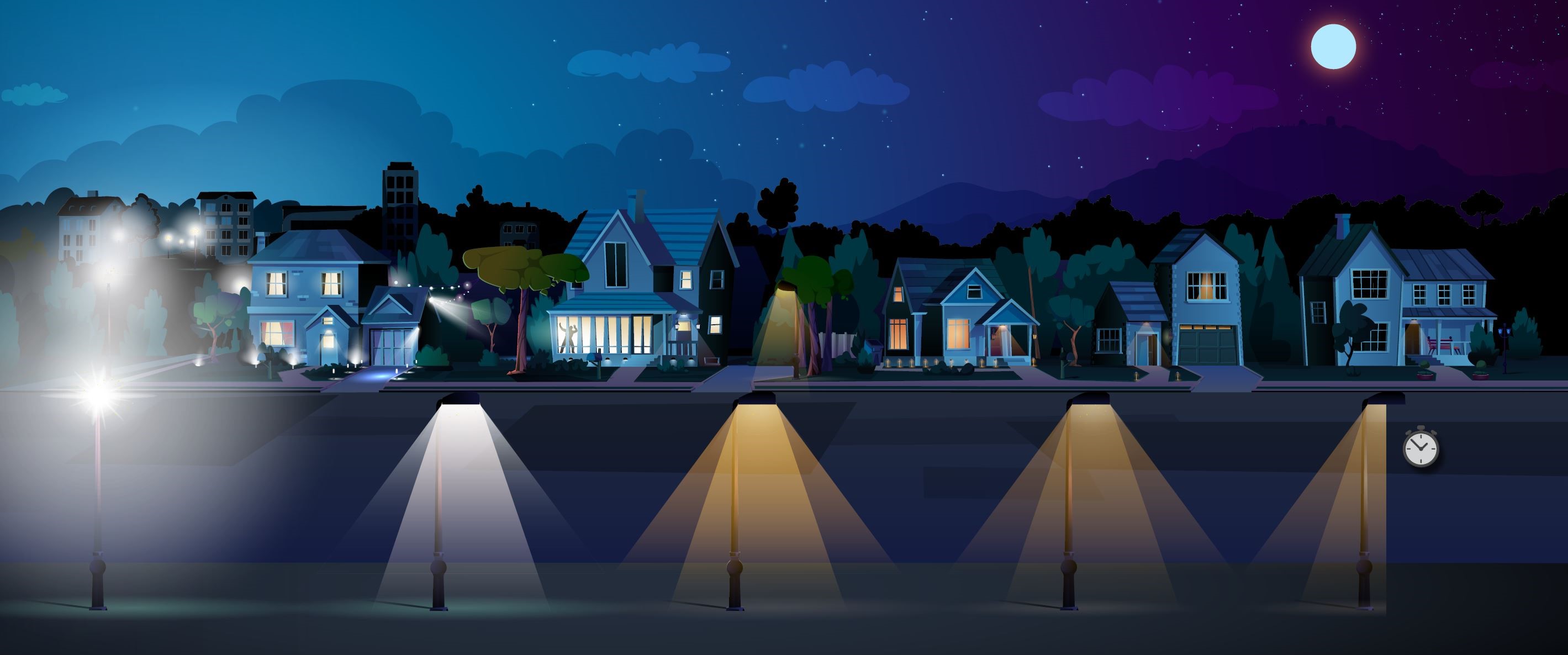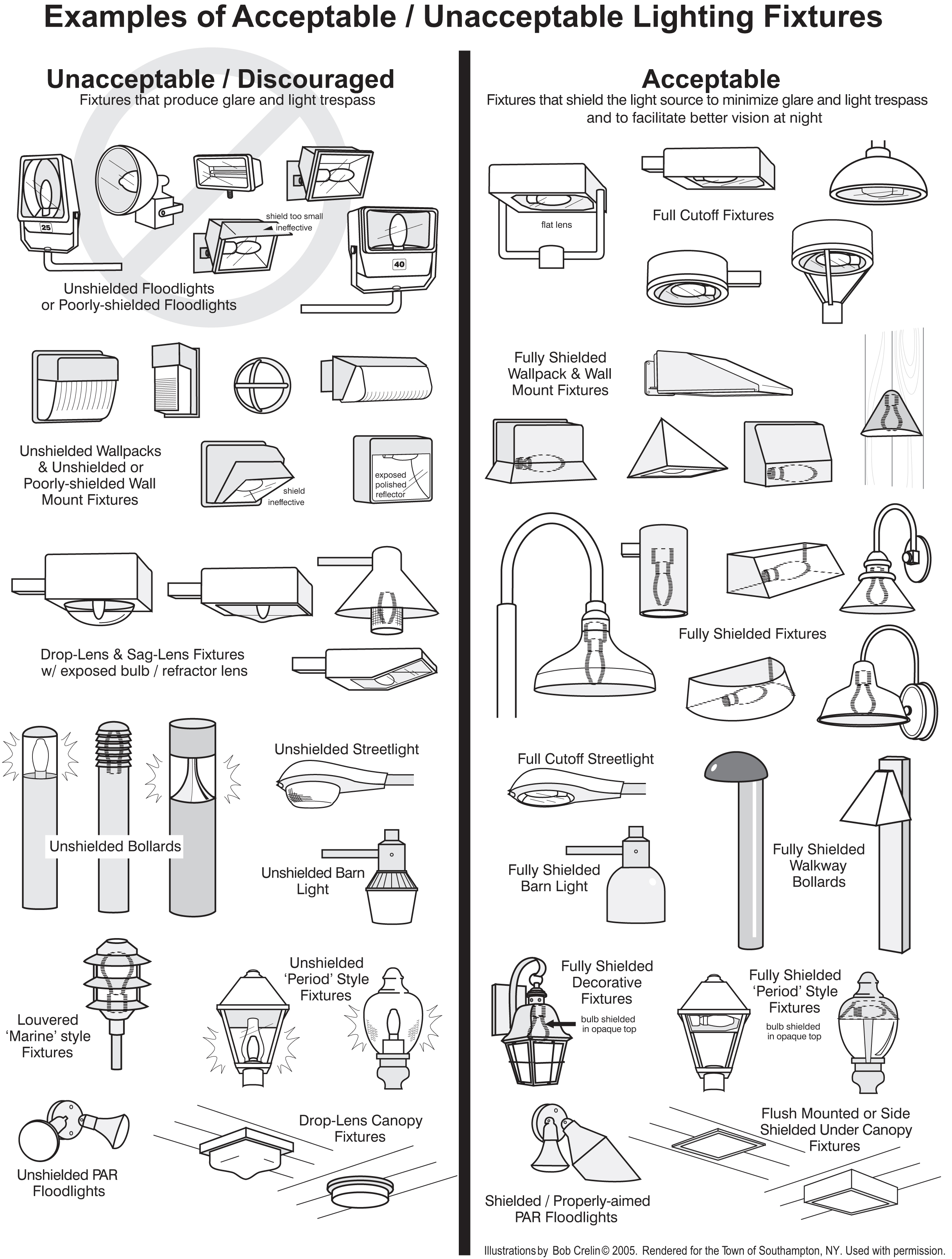Lighting Questions & Contact
Do you have a question, issue, or concern about outdoor lighting?
Frequently Asked Questions
- What are night-sky friendly lights?
- Where can I buy night-sky friendly light fixtures?
- There are bad lights in my community. What should I do?
- How can I help protect the night sky?
- Are night-sky friendly lights more expensive?
- Isn't it less safe to use dimmer lights?
- How are the lighting ordinances in West Texas enforced?
Answers to the FAQs
What are night-sky friendly lights?
In general, night-sky friendly lights help reduce light pollution and save energy by directing the light they produce to the ground where it is needed.
Night-sky friendly lights have the following properties:
- Shielding: The light bulb or light source should not be visible from the property boundary or off-property. Lights should be aimed down, with fixtures parallel to the ground.
- Color: The light sources should have a color temperture of 2,700K or below (soft white/ amber).
- Intensity: Lights should not emit more light than is necessary. The total output should not exceed 50,000 lumens per net acre for businesses or public spaces, or 25,000 lumens per net acre for residential areas. (Add up lumens of each bulb).
- Timing: All lights should have a clear purpose for being on. Lights that are not in use, including business signs or decorative lights after hours, should be turned off, put on a timer to turn off automatically, or only actived temporarily with a motion sensor.
Where can I buy night-sky friendly light fixtures?
The International Dark Sky Assocation is a good resource and provides a seal of approval to light fixtures. When shopping for light fixtures, look for shields which are flush or extend below the bottom of the bulb. Some fixtures may have shields that are too short to be effective. If you can see the bulb or light source from the edge of the property, it is not shielded well enough to protect night skies.
Wall-mounted floodlights, such as PAR-style lights commonly found on many homes and businesses (see examples image), can easily be made night-sky friendly by using a PAR38 size shielded fixture with an undersized PAR20 bulb, and tilted downwards.
Pay attention to the lumens a bulb emits when shopping. For most outdoor residential applications, it is usually not necessary to exceed 1000 lumens per bulb, and values around 500 lumens are typically more than enough. A lower lumen output can be used with a shielded fixture because the light is more focused.
There are bad lights in my community. What should I do?
First, educate yourself on the benefits of night-sky friendly lights and consequences of light pollution. This video is a good starting place. Make sure your own home or business uses night-sky friendly lights before approaching a neighbor or community member about their lights.
Contact the owner of the property. Be polite and provide resources to support your explanations. In most cases, people are unaware that their lights are causing a problem. The goal is to make a friend, not an enemy. Check to see if your area has an outdoor lighting ordinance, but don’t start the conservation by highlighting a violation. Avoid making blunt accusations and stay positive.
It may be useful to provide examples of night-sky friendly lights. This could be your property or one of McDonald Observatory’s Recognized Businesses and Organizations. You could also consider providing a sample light fixture for them to install as a demonstration.
Ask the property owner for their advice for solving the problem. Hear their ideas and address concerns directly. For example, they may have concerns about safety or security. You could remind them that our goal is a dark night sky, not a dark ground. Night-sky friendly lights are safer because they produce less glare and more evenly illuminate obstacles.
If you live in an area with an outdoor lighting ordinance, you may choose to report violations to your local government. Copies of outdoor lighting ordinances in West Texas are available on our Additional Resources page. Reporting ordinance violations should be a last resort. We strongly advise against reporting if the property owner has not been made aware of a possible code violation or are making a good faith effort to improve.
In general, asking a Code Enforcement Officer or Observatory staff member to address a community member may be interpreted as an escalation and could generate hostility. It is most effective for individuals to address neighbors and community members personally, especially if you already know them. Alternatively, if talking to your neighbor is ineffective, you can write a letter expressing your concerns and bring the issue to the attention of the relevant county or city commissioner, mayor, or judge.
For more information on how to approach a community member about their lights, see this helpful page by the IDA. You may also contact us to get advice on additional resources for West Texas. Observatory staff can help provide information and educational programs related to preserving dark skies. However, we do not have authority to enforce lighting ordinances.
How can I help protect the night sky?
The most helpful thing you can do is use night-sky friendly lighting in your own home or business, and tell your friends and neighbors to do the same.
If you're already practicing good lighting, you can help support our efforts by donating to the Dark Skies Initiative fund (select "McDonald Observatory" and "Dark Skies Initiative" in the drop-down menus). These funds will go towards upgrading and replacing light fixtures in the area, and promoting awareness of good lighting practices. You can also apply for our Recognition Program if you are in West Texas.
You can also get involved in your local community by joining a chapter of the International Dark Sky Association, or join local grassroots efforts such as the West Texas Friends of the Night Sky or Big Bend Conservation Alliance.
Are night-sky friendly lights more expensive?
Although shielded light fixtures may be slightly more expensive than simple bare bulbs, by directing the light to the ground, night-sky friendly lights waste less light and energy. In most traditional lighting designs, 30% or more of the light produced is wasted by shining into the sky. Because night-sky friendly lights are more effective at putting light where it is needed, less energy can be used to obtain the same levels of illumination, resulting in long-term cost savings. Reducing illumination levels to prevent over-lighting can also result in energy savings.
Some fixtures can be made night-sky friendly with simple adjustments like aiming them down. In the majority of residential lighting sitauations, night-sky friendly options are plentiful and cheap.
In certain cases, McDonald Observatory will help offset the cost of improving light fixtures in Far West Texas using donated funds allocated for this purpose. Contact us for more information.
To further reduce the cost of improving light fixtures, the utility provider AEP (American Electric Power) will install fixtures for free on public structures if provided with a night-sky friendly light.
Isn't it less safe to use dimmer lights?
Contrary to popular belief, brighter isn't always safer. Bright white lights aimed outwards produce glare that decreases visibility and produces dark shadows where obstacles can hide. Bright lights also ruin our eye's natural ability to adapt to ambient conditions, which makes transitions between differently lit areas more dangerous. Night-sky friendly designs have been shown to be safer by providing more even illumination and by eliminating glare.
Most property crimes occur during daytime hours, and some studies have shown that providing more light at night may actually increase the likelihood of some crimes and accidents. Lights are not the top deterrent for criminal activity.
How are the lighting ordinances in West Texas enforced?
Enforcement of lighting ordinances is the responsibility of the municipalities or counties that enact them. By state law the seven counties surrounding McDonald Observatory are required to have lighting ordinances in place to help protect the sky. These ordinances are separate from but overlap efforts related to the proposed Greater Big Bend International Dark Sky Reserve, which includes further measures to protect the night sky.
- Jeff Davis
- Presidio
- Brewster
- Reeves
- Pecos
- Hudspeth
- Culberson

Within these counties are numerous municipalites which each have their own versions of outdoor lighting ordinances, such as Alpine, Marfa, Presidio, Valentine, and other cities. Unincorportated communities such as Fort Davis, Terlingua, Marathon, and others are subject to the county level ordinances. Copies of some of these ordinances can be found on the Additional Resources page.
Lighting ordinances almost always include a grandfathering clause, which states that fixtures installed before a certain date (usually the date the ordinance was enacted) are not subject to the ordinance, or only will be subject to the ordinance after a certain time period after being enacted. In most cases, that time period is 5 years. For Jeff Davis, Presidio, and Brewster Counties, and all municipalties within, all lights will need to be in compliance by 2026 when the grandfathering clauses expire. All new or replacement light fixtures installed must be compliant with the ordinance now.
While enforcement measures vary, in most cases violations are punishable by a fine determined by the municipality or county. Cases of violations are usually addressed as a result of a complaint to the county or code enforcement; police generally do not patrol streets to look for violations. In general, the role of these ordinances is to raise awareness of lighting practices and create recommendations for best practice rather than punish violators. Violators are notified by the county or municipality and given time to address the problem before any enforcement action is taken or fine issued.



